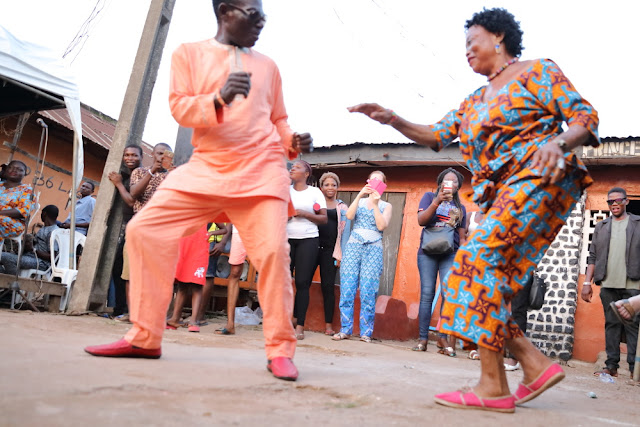 |
| High Chief Arala of Benin Kingdom, Prince S.B. Omo Lawal Osula |
At the intersection of two potholed market streets in the heart of Benin City, somewhere along Lagos street, stood three marquees. Two of them were covering rows of plastic chairs and a plastic table for special guests. The third one was covering a wooden stage with numerous microphone booms. A band was getting ready to play. The setup was facing the house of the Arala, a High Chief of Benin City. In front of the house painted in orange was a wooden bank on which traditional percussionists would seat later on. Seated guests were waiting for the Arala himself.
The Arala had come out, dressed in a salmon-pink suit and red loafers, to welcome us personally upon our arrival while we parked next to the marquees. He is a man of small stature but fit and lively for his age (he is in his mid seventies). The Arala runs an NGO to help international organisations fund rural education projects around Benin city. The NGO spares them to interface directly with the government and helps making sure the funds are not vanishing into unintended pockets. The Arala had invited our group because one of us, a western diplomat, was to receive an award for an existing or future collaboration. The lady, heading the NGO, followed him to greet us.
 |
| Austin singing "to lay good foundation, earlier the better, in the nearer future we'll be one of the leaders, so we pray, Amen..." |
As we all sat down, the music started with Austin and his band. He was playing with his guitar something along the lines of "to lay good foundation, earlier the better, in the nearer future we'll be one of the leaders, so we pray, Amen...". Then the head of the NGO made a speech to welcome us and say that we were welcome, praising in passing the great Bini hospitality (from Benin people living in Edo state).
The Arala made his official entrance, wearing an emerald-coloured agbada. He was sporting sunglasses too. He said, in his introduction speech, that he had been in the entertainment business for fifty-six years and a half. This was, I reflected, a strong enough justification to wear sunglasses as a famous music artist (
Victor Uwaifo too is wearing some while receiving guests in his living room). Kola nuts were brought and presented to the guests, some Seaman gin was shared among senior people.
 |
| the Priestess dancing is married to the Arala |
The Arala invited one of his wife, a priestess, to come and dance barefoot in front of us. She was wearing a large white summer dress embroidered with cowries, leaving the shoulders and arms bare. Her hair ended in a giant dreadlock that she would menacingly rotate in the air in some of her dance moves. She had a coral crown that slid off her head, while she was dancing, and landed on the ground that, in a distant past, had once been a smooth layer of concrete. She was holding two objects: one flame-shaped bronze piece and a large white and blue heart-shaped fan. Her face was made-up with kaolin. She used her fan to share kaolin with some of the guests. Her dance appeared to be deeply spiritual, she was at time closing her eyes as if trying to reach or communicate with some inner parts of her mind and at other times very alert, her eyes flashing like a warrior ready to jump on her enemies and slaughter them. Drums were infusing the rhythm accompanied by a metal bell-shaped triangle. VIPs got up and sprayed fresh mint (20 naira notes) on the ground as a sign of appreciation so that family members could collect them in a bag.
 |
| the largest family band on Earth has been successfully appreciated |
After her performance had been copiously applauded and cheered, the Arala went on stage and made a speech about the history of Benin culture, reiterated the sense of hospitality of local people. He then handed an award to the diplomat and said he would perform half and hour for us with all his wives. He proudly said that we would witness a performance from the largest family band on Earth (no one had access to the Guinness Book of Records to verify the claim!). The Arala is an example of a large polygamous family, with eight wives, fifty-two children and over a hundred grand children. He was bragging about being able, with his children, to make a concert simultaneously on the five continents and went on saying "this is why we always say that Bini people are always number one in whatever they do". He introduced each of his wives, all bigger and taller than him.
He dropped his robe and the mini-concert started on a highlife mood. He then playfully danced separately with each of his wives according to various themes that all reminded us that at some point a man and a woman are made to "bump" into each other.
 |
| martial dance, wait a minute |
The night had come, and most guests were told to leave while a few of us were invited to share some food before parting as it is appropriate in the African custom. We were served some delicious pounded yam with egusi soup.





Comments
Post a Comment